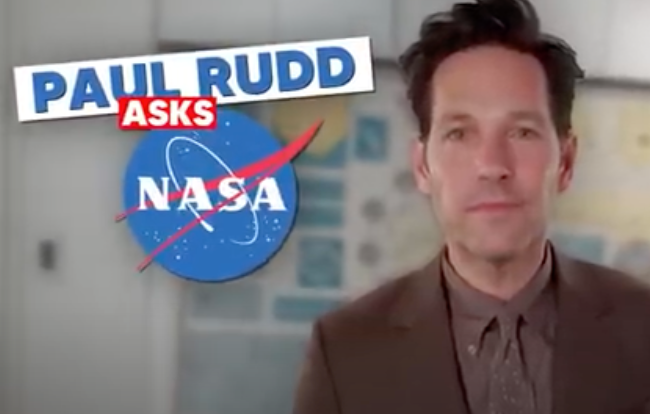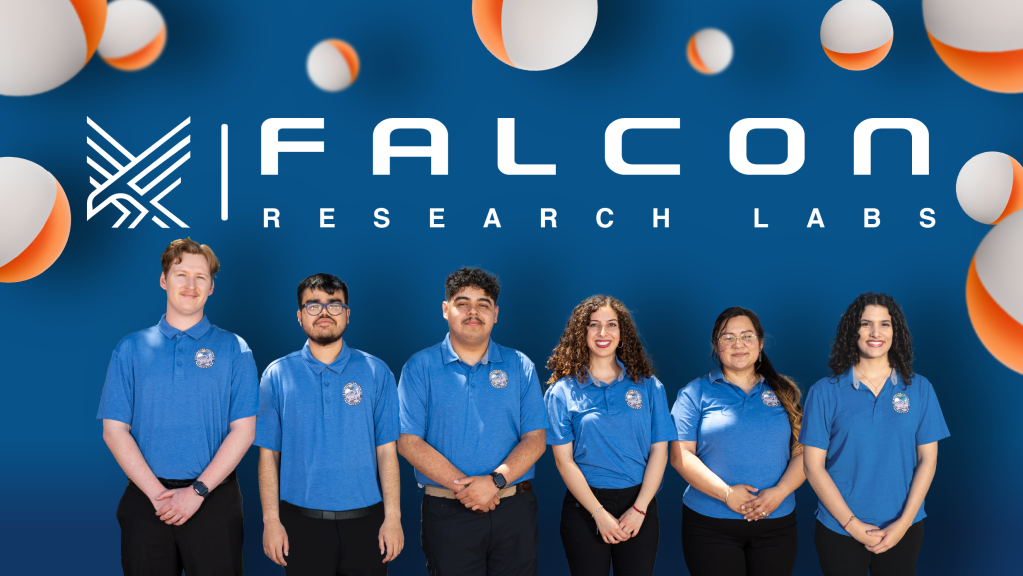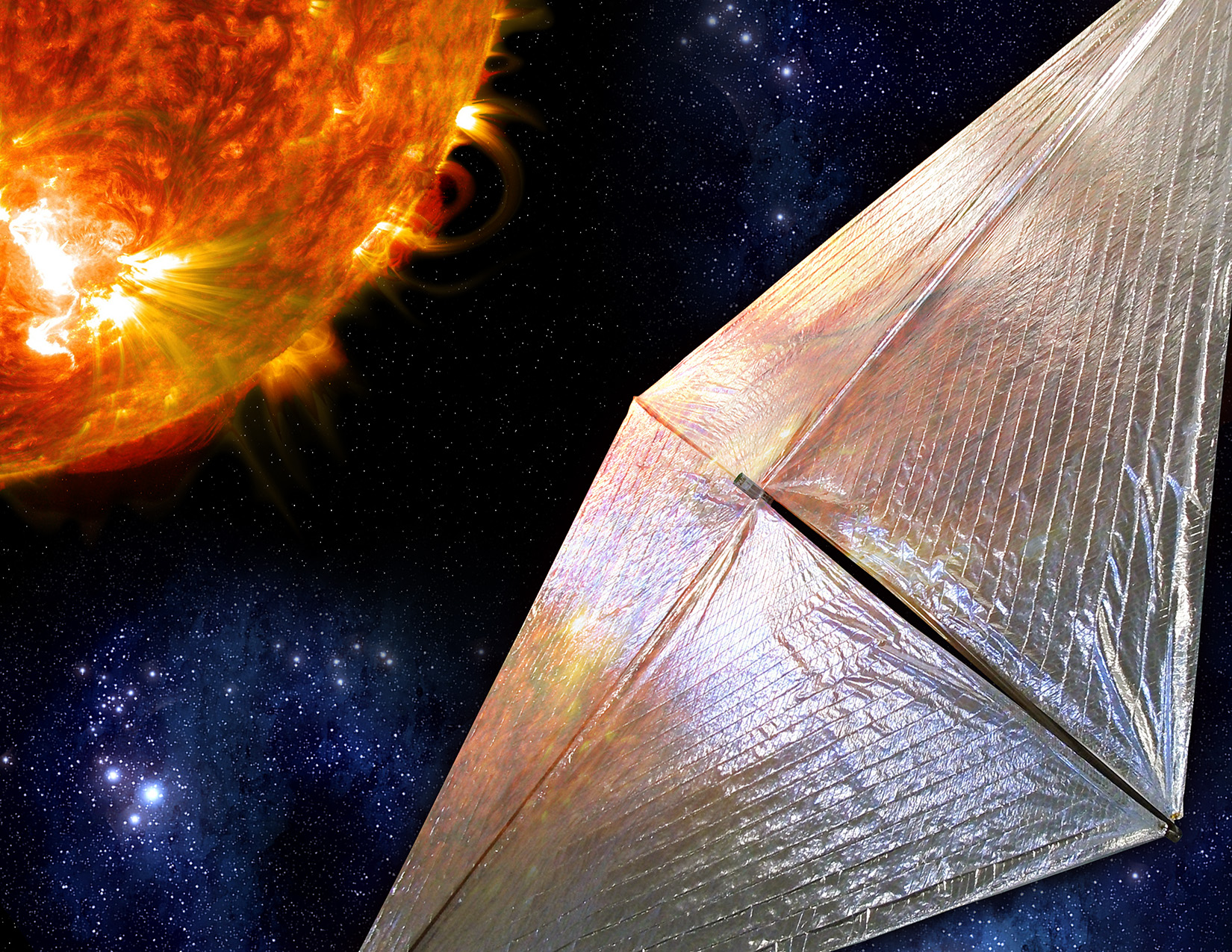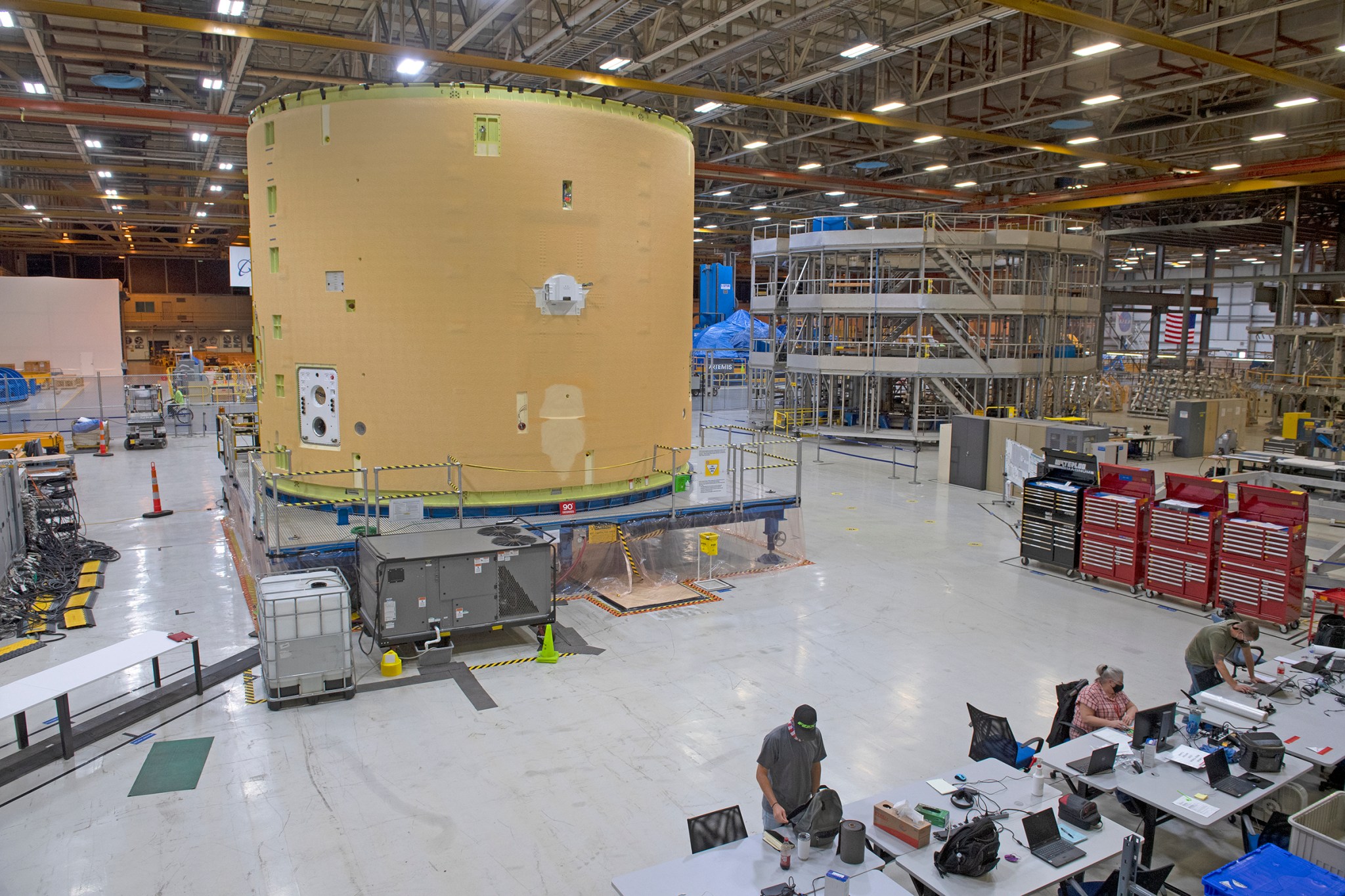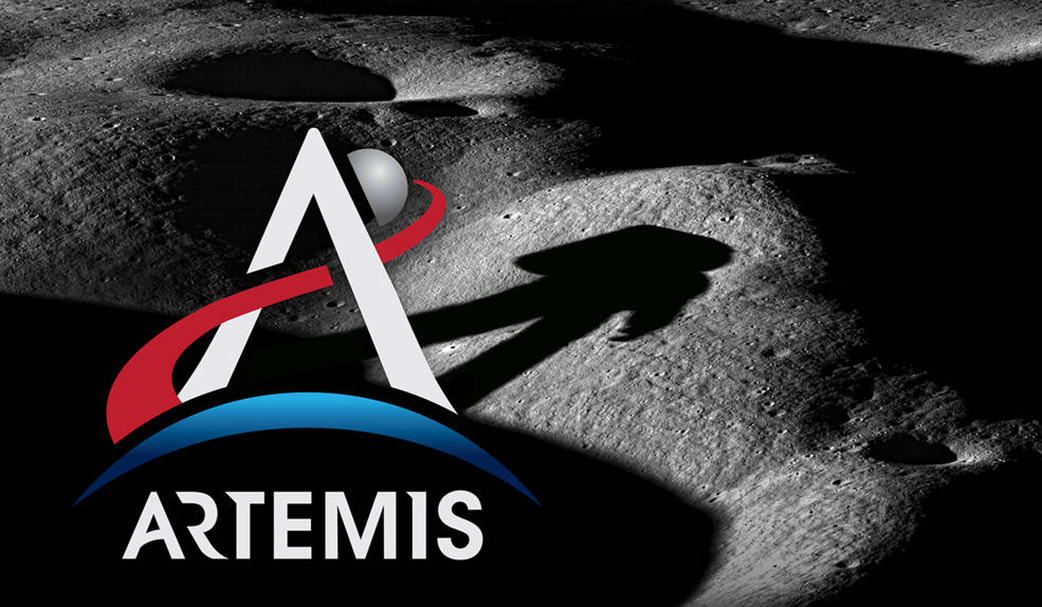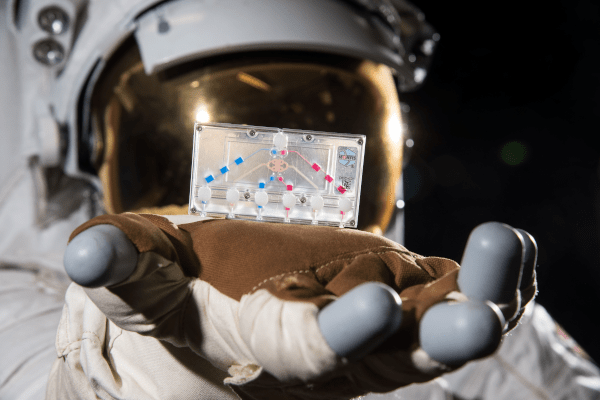In This Week’s Star
- NASA Selects Marshall-led Solar Cruiser to Demonstrate Solar Sail Propulsion
- NASA Building Core Stages for Artemis II, III Missions
- NASA Defines Science Priorities for First Crewed Artemis Moon Landing
- Celebrating 20 years of Space Station Exploring, Understanding, Testing
- Five Marshall Team Members Honored with Trailblazer Award
- Marshall Team Gathers Virtually to Usher in Season, Light Holiday Tree
- This Week in NASA History: Apollo 17 Lands on Lunar Surface – Dec. 11, 1972
NASA Selects Marshall-led Solar Cruiser to Demonstrate Solar Sail Propulsion
NASA has selected Solar Cruiser – a SmallSat mission led by principal investigator Les Johnson of the agency’s Marshall Space Flight Center – to share a ride to space in 2025 with the Interstellar Mapping and Acceleration Probe.
Solar Cruiser was selected as the technology demonstration mission. Consisting of a nearly 18,000-square-foot solar sail, it will demonstrate the ability to use solar radiation as a propulsion system. Such a system could provide access to new orbits enabling high-value science, including SmallSat observations from deep space, out of the ecliptic plane, and in stationary orbits in Earth’s geo-tail.
Solar Cruiser will demonstrate one such orbit, where a spacecraft maintains position along the Earth-Sun line at a point closer than the first Lagrangian equilibrium point – about 1 million miles toward the Sun. By positioning a monitoring spacecraft closer to the Sun, space weather scientists hope to obtain more advanced warnings of solar storms headed to Earth.
“Once it’s deployed in space,” Johnson said, “our mission will demonstrate solar sail propulsion so that future missions using it can take heliophysics instruments to study the Sun from new destinations and novel vantage points not available to any other type of propulsion.”
The Solar Cruiser investigation is budgeted for $65 million.
NASA selected the Global Lyman-alpha Imagers of the Dynamic Exosphere, or GLIDE, to launch alongside Solar Cruiser, as Solar Terrestrial Probes Missions of Opportunity. As the selected science mission, GLIDE will study variability in the upper reaches of Earth’s atmosphere – the exosphere, where it touches space – by tracking far ultraviolet light emitted from hydrogen. Lara Waldrop at the University of Illinois at Urbana-Champaign is principal investigator for GLIDE, which is budgeted for $75 million.
The launch of the Interstellar Mapping and Acceleration Probe mission to the first Lagrangian equilibrium point will be a pathfinder for NASA’s new RideShare policy. With the policy, the agency’s Science Mission Directorate will plan – from the inception of major missions – to take advantage of excess launch capacity and provide increased access to space for SmallSats. The mission will help researchers better understand the interstellar boundary region, where the solar wind and the solar magnetic field it transfers to the edge of the solar system collide with galactic material and the galactic magnetic field.
Focusing on small satellites and tech demonstrations helps prove the capabilities of these smaller missions while pairing them with existing missions for launch provides more avenues for learning about the solar system and developing innovative technical capabilities.
Solar Cruiser will demonstrate a new type of propulsion in space that uses no fuel – a solar sail. It works by reflecting sunlight & that reflected light pushes it through space. Congrats to Principal Investigator Les Johnson at @NASA_Marshall! pic.twitter.com/ZkdqrF8yj1
— Thomas Zurbuchen (@Dr_ThomasZ) December 3, 2020
“The study of the solar influence on interplanetary space and the area around Earth has made great advances just in the past decade,” said Thomas Zurbuchen, associate administrator for science at NASA Headquarters. “I’m confident the next decade promises even more new discoveries and historic technology innovations.”
A second science Mission of Opportunity, the Spatial/Spectral Imaging of Heliospheric Lyman Alpha also was provided funding toward a final selection decision at a later date based on budget and RideShare opportunities. The science mission would use an innovative technique to map the entire sky to determine the shape and underlying mechanisms of the boundary between the heliosphere, the area of the Sun’s magnetic influence, and the interstellar medium, a boundary known as the heliopause.
“Launching several missions together helps us maximize science while keeping costs down,” said Nicky Fox, Heliophysics Division director at NASA Headquarters. “We’re expanding the range and composition of a robust fleet of missions studying the Sun and space weather, and these two new selections will help advance into areas where we need to know more.”
The Interstellar Mapping and Acceleration Probe launch will also include the National Oceanic and Atmospheric Administration’s Space Weather Follow-On mission, which will expand that agency’s space weather forecasting.
Funding for these missions comes from the Heliophysics Solar Terrestrial Probes program, which is managed by NASA’s Goddard Space Flight Center. For more information about NASA’s Heliophysics Division, visit here:
NASA Building Core Stages for Artemis II, III Missions
Technicians are simultaneously manufacturing NASA’s Space Launch System core stages for the Artemis II and Artemis III lunar missions at NASA’s Michoud Assembly Facility.
The core stage for the deep space rocket consists of two huge propellant tanks, four RS-25 engines, and miles of cabling for the avionics systems and flight computers. All the main core stage structures for Artemis II, the first mission with astronauts, have been built and are being outfitted with electronics, feedlines, propulsion systems, and other components. Technicians are currently wiring and performing functional tests on the avionics inside both the forward skirt and intertank sections. The engine section – the most complicated part of the stage – is in production assembly.
Engineers are welding the core stage structures for the Artemis III mission through a process called friction stir welding. Each of the structures for the core stage has rings that attach the pieces together to produce one stage during final assembly. The rings are trimmed down to 1/1000th of an inch at the ring machining center, then sent to another part of the facility for the next phase of manufacturing. Once completed, the hardware will help launch the first woman and the next man to the lunar surface.
The manufacturing progress for Artemis II and III comes as the core stage for the Artemis I SLS rocket undergoes Green Run testing at NASA’s Stennis Space Center.
NASA Defines Science Priorities for First Crewed Artemis Moon Landing
A new NASA report has identified the agency’s science priorities for the Artemis III mission, which will launch the first woman and next man to the Moon in 2024.
The Artemis III Science Definition Team, comprised of federal employees and consultants with expertise in lunar science, began meeting in September to define compelling and achievable science objectives for all aspects of the Artemis III mission, including sampling strategies, field surveys, and deployable experiments.
The Moon often is referred to as the cornerstone of the solar system, and these high-priority investigations will help scientists better understand fundamental planetary processes. In addition, the team prioritized investigations that will help NASA understand the risks and potential resources of the Moon’s South Pole, where the agency hopes to establish its Artemis Base Camp concept by the end of the decade.
“Even before Artemis III lands, our agency’s science and human exploration teams are working together as never before to ensure that we leverage each other’s strengths,” said Thomas Zurbuchen, associate administrator for NASA’s Science Mission Directorate. “This report helps outline a path forward toward the compelling science we can now contemplate doing on the lunar surface in conjunction with human explorers.”
Questions the team explored include how to approach investigations and key science activities on the Moon and how to incorporate science into the concept of operations for the crewed mission to the lunar surface. The team also solicited papers from, and drew from existing reports outlining the highest science priorities of, the lunar science community, which for decades has been preparing for the return of humans to the Moon.
“The work NASA is already doing in science will help prepare for the Artemis III landing in 2024 and maximize the science value of having humans back on the lunar surface for the first time since 1972,” said Kathy Lueders, associate administrator for NASA’s Human Exploration and Operations Mission Directorate.
As was the case during Apollo-era lunar exploration, every second of an astronaut’s time on the lunar surface will be meticulously planned. The report will provide a resource for mission planners developing crew surface activities, including field geology, sample collection and return, and deployed experiments – all necessary to advance a high-priority science program at the Moon.
The team also will assess what science goals could be realistically executed during the Artemis III surface mission. NASA will develop a detailed mission operations plan when human landing system capabilities and other details come into sharper focus. Procedures and operations techniques developed for Artemis III also will inform future missions.
“We wanted to bring together what was most compelling to the science community with what astronauts can do on the lunar surface, and how the two can reinforce each other,” said team co-chair Renee Weber, chief scientist at NASA’s Marshall Space Flight Center. “The team’s hard work will ensure we’re able to take advantage of the potential of Artemis III to help us learn from the Moon as a gateway to the rest of the solar system.”
NASA’s science and human exploration teams will work together to integrate recommendations into the science strategy of NASA’s Artemis Plan as the agency prepares for the Artemis III crewed launch.
Artemis III will enable the science community to make significant progress on key science goals, including increasing understanding of how the Moon formed and evolved, how it interacts with the Sun, and how water and other resources arrived at the Moon, are transported, and currently are preserved.
Celebrating 20 years of Space Station Exploring, Understanding, Testing
Editor’s note: This is the second in a five-part series highlighting scientific and technological breakthroughs that have been achieved over the past two decades as a result of International Space Station science. This research helps humanity explore farther into space while also benefiting life on Earth. The Payload Operations Integration Center at NASA’s Marshall Space Flight Center schedules, assists with, and coordinates all experiments on the station’s U.S. Orbital Segment.
Orbiting approximately 250 miles above Earth, the International Space Station has been home to 20 years of unique scientific opportunities such as developing methods to combat muscle atrophy and bone loss, exploring the fifth state of matter, understanding how the human body changes in microgravity, and testing tissue chips in space.
Methods to combat muscle atrophy and bone loss: The human body evolved within the constant pull of Earth’s gravity. In microgravity, bones and muscles do not have to support the body’s mass – which can cause bone and muscle loss without proper exercise. Space studies have contributed greatly to the understanding of bone and muscle loss in astronauts and in people on Earth.
On Earth, bone and muscle atrophy occurs from normal aging, sedentary lifestyles, and illnesses. This condition may cause serious health issues from injuries due to falls or osteoporosis. Studying these losses in microgravity can help scientists better understand them and potentially create treatments for people on Earth.
Understanding how to mitigate the effects of microgravity on bones and muscles is important for future exploration in the partial gravity environments of the Moon and Mars. Scientists have developed an exercise routine and diet regimen that significantly reduces the bone and muscle loss astronauts otherwise would experience during their stays on station.
The OsteoOmics experiment investigated mechanisms behind bone formation and loss. Rodent Research-19 analyzed drugs that target myostatin, which influences the breakdown of muscles and bones. Researchers have even tested tiny chips for delivering drugs to combat muscle loss.
Exploring the fifth state of matter: Twenty-five years ago, scientists on Earth first produced a fifth state of matter with properties totally unlike solids, liquids, gases, and plasmas. The achievement garnered a Nobel Prize for those scientists and changed the field of physics.
In 2018, NASA’s Cold Atom Lab became the first facility to produce that fifth state of matter – called a Bose-Einstein condensate in Earth’s orbit. The Cold Atom Lab lowers atoms to ultracold temperatures in order to study their properties in ways not possible on Earth.
Chilling atoms is the only way to produce a Bose-Einstein condensate, and ultracold atom facilities in space reach colder temperatures than labs on Earth. Additionally, scientists produce Bose-Einstein condensates in a vacuum, so on Earth the atoms are pulled down by gravity and fall quickly toward the floor. This movement typically limits observation times to less than a second without the help of magnetic or optical fields that influence the atoms’ behaviors. In microgravity, Bose-Einstein condensates can float, providing longer observation times.
Bose-Einstein condensates collectively exhibit properties typically displayed only by individual atoms, making those microscopic characteristics visible at a much larger scale. This study can provide insight into fundamental laws of quantum mechanics and could support the development of quantum technologies such as ultraprecise sensing and timekeeping.
Understanding how bodies change in microgravity: Before humans head to Mars, NASA wants to know what challenges they will face. Long-term stays aboard the space station have allowed scientist to uncover and begin solving challenges that could be presented by the human body’s response to space. For example, some space station astronauts unexpectedly developed vision changes, now known as Spaceflight-Associated Neuro-Ocular Syndrome. Findings include swelling at the optic disc and flattening at the back of the eyeball. After helping discover the issue, space station research has served as a platform to better understand the syndrome.
NASA’s Twins Study compared astronaut Scott Kelly during his year in space with his Earth-bound twin brother Mark Kelly. It provided insights into the many ways long-term spaceflight affects a human body. Findings showed that Scott’s gene expression changed and his body reacted appropriately to vaccines while in space.
Testing tissue chips in space: Many of the changes in the human body caused by microgravity resemble the effects of diseases associated with aging on Earth. These changes occur much faster in space. Scientists may be able to model changes that might take months or years to happen on Earth using tissue chips – thumb-drive-sized devices that contain human cells in a 3D matrix, representing functions of an organ. These represent a big step in the ability to test how those cells respond to stresses, drugs, and genetic changes.
The Tissue Chips in Space initiative seeks to use these devices in microgravity to better understand and improve human health and disease treatment on Earth. Chips simulating lung, kidney, brain, and intestine behavior all have been sent to the space station by a branch of the National Institutes of Health and the ISS U.S. National Lab.
To learn more about these breakthroughs and other scientific advancements made aboard the space station, visit here.
Five Marshall Team Members Honored with Trailblazer Award
By Taylor Goodwin
Five team members from NASA’s Marshall Space Flight Center were honored with the agency’s Space Flight Awareness Trailblazer Award in a virtual ceremony Nov. 18.
The annual award is presented to NASA civil servants and contractors who demonstrate strong work ethic and creative, innovative thinking in support of human spaceflight in the first seven years of their career. Marshall recipients were Luke Scharber, Joel Amert, Cynthia Hubbard, Daniel Mailman, and Ethan Walker.
“The SFA program reminds every employee involved in human spaceflight of their important role in promoting safety and mission success in the challenging task of flying humans in the hostile environment of space,” said Alotta Taylor, SFA program manager at NASA Headquarters. “I would like to congratulate and thank today’s Trailblazer Award recipients as well as management and co-workers of the employees who are receiving an award in this first-ever virtual SFA award ceremony for their support.”
Astronaut Andrew Morgan, who just returned from a nine-month stay on the space station, joined the virtual ceremony to address the award recipients.
“Your vigilance in safety and mission success gives me the confidence to look at the friends and family of my crewmates and assure them that everything will be perfect,” he said. “In order for NASA to retain its competitive edge at such an important time in space history, I encourage you to continue the creative innovation that we’re here to recognize today.”
Scharber – an engineer – was recognized for creating a small projects and innovation laboratory, excelling in finding innovative solutions to complex problems, and giving his time to mentoring and volunteering. He has lent high levels of innovation, creative initiative, and technical excellence to Marshall’s Structural and Dynamics Analysis Branch.
Amert, an engineer, was honored for his innovation and leadership in developing flight hardware and software testing methods for NASA’s Space Launch System rocket.
Hubbard, a contracting officer supporting the Office of Procurement, was recognized for her exemplary support to the Safety and Mission Assurance Indefinite Delivery Contract and the center.
Mailman, a budget analyst, received recognition for his innovation and analytical contributions while leading a comprehensive and streamlined budget process as the resources integrator in the Office of the Chief Financial Officer.
Walker, a budget analyst, was honored for his outstanding resources innovation and teamwork in support of the Office of the Chief Financial Officer, Space Systems Support Team.
Preston Jones, Marshall associate director, technical, addressed the center’s honorees.
“These folks have shown that they’re true problem solvers, leaders, hard workers, and team players,” Jones said. “I want to thank all the awardees for what they do – and I also want to thank those around them for encouraging them, supporting them, and shaping the values that brought them to us.”
Each awardee will receive a certificate signed by Kathy Lueders, associate administrator for NASA’s Human Exploration and Operations Mission Directorate; a special commemorative spaceflight item; and the opportunity to shadow a NASA executive.
Goodwin, a Media Fusion employee, supports Marshall’s Office of Strategic Analysis & Communications.
Marshall Team Gathers Virtually to Usher in Season, Light Holiday Tree
By Rick Smith
On Dec. 2, NASA’s Marshall Space Flight Center leadership and team members gathered virtually to welcome the festive season, remotely enjoy some after-hours camaraderie, and observe the annual lighting of the Marshall holiday tree.
Participating team members concluded the workday with online games, an ugly sweater contest, and more. Marshall Director Jody Singer, Deputy Director Paul McConnaughey, Associate Director Steve Miley, and Associate Director, Technical, Preston Jones – led the traditional tree lighting ceremony.
“We wanted to make sure we carried on this tradition no matter what,” Singer told team members. “Each and every one of you has worked so hard this year. I really appreciate those helping with critical mission assignments on-site, and those keeping our facilities up and running, keeping us safe, and cleaning our buildings.”
She also hailed the contributions of the thousands of team members who continue sustaining the nation’s mission in space via telework throughout a turbulent year.
“You’re making a huge difference,” she added.
A planned virtual greeting from Kriss Kringle was postponed due to unavoidable technical difficulties at the North Pole.
“We’re told Santa had issues with the feed,” said event organizer Betty Grisham, a program support specialist in the Office of Strategic Analysis & Communications. “He may have thought we meant reindeer feed, we’re not sure.”
The Marshall holiday celebration was organized by the Marshall Exchange and the Office of Strategic Analysis & Communications.
Smith, a Manufacturing Technical Solutions employee, supports Marshall’s Office of Strategic Analysis & Communications.
This Week in NASA History: Apollo 17 Lands on Lunar Surface – Dec. 11, 1972
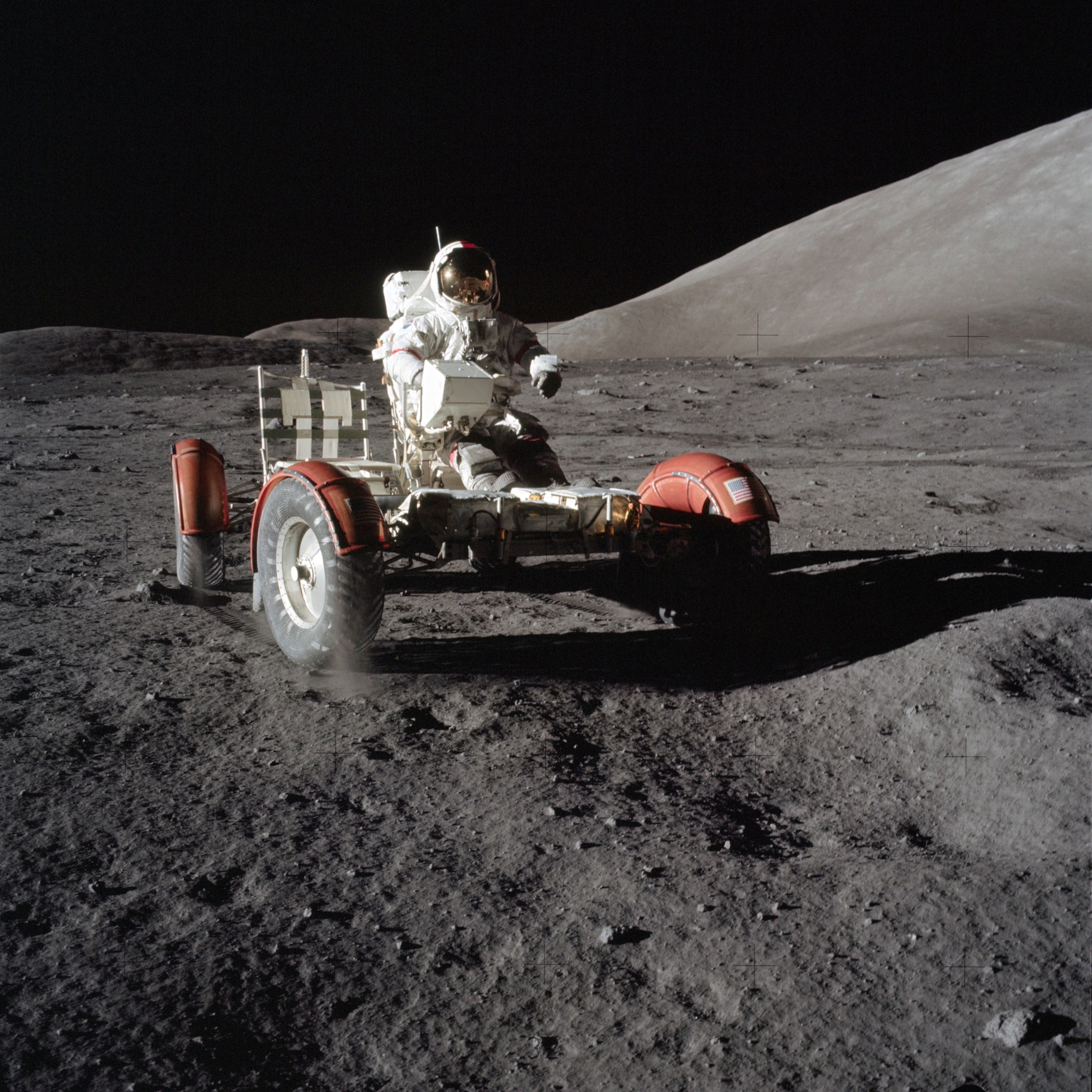
This week in 1972, Apollo 17 landed on the lunar surface and became the third and final mission to employ the Lunar Roving Vehicle – a lightweight, electric vehicle designed to operate in the low-gravity vacuum of the Moon. It allowed Apollo astronauts to extend the range of their moonwalks. Here, astronaut Eugene Cernan, Apollo 17 commander, makes a short checkout of the Lunar Roving Vehicle during the early part of the first Apollo 17 moonwalk at the Taurus-Littrow landing site. Today, NASA’s Marshall Space Flight Center is playing a vital role in the Artemis program by developing the Space Launch System, the backbone of NASA’s exploration plans and the only rocket capable of sending humans to the Moon and Mars. The NASA History Program is responsible for generating, disseminating, and preserving NASA’s remarkable history and providing a comprehensive understanding of the institutional, cultural, social, political, economic, technological, and scientific aspects of NASA’s activities in aeronautics and space. For more pictures like this one and to connect to NASA’s history, visit the Marshall History Program’s webpage. (NASA)













